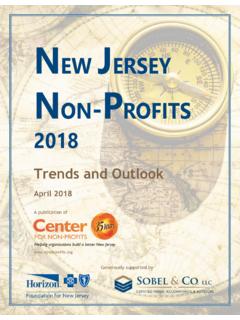Transcription of THINKING OF FORMING A NON-PROFIT?
1 THINKING OF FORMINGA NON-PROFIT? What to Consider before You BeginA publication ofMade possible by:The J. P. Morgan Chase FoundationTABLE OF CONTENTS1So, You re THINKING About Starting a is a Non-Profit, Anyway?6 First Steps for Building a Strong Base9To Be or Not to Be? The Legal Questions15 FORMING a Religious Institution: Legal Options17 Spinning Off a New Non-Profit:The Advantages and Risks for Houses of Worship23 Introduction to the Non-Profit Board25 The Changing Face of the Non-Profit Sector andthe Challenges that Lie Ahead28 ResourcesThinking of FORMING a Non-Profit? What to Consider before You Begin is published by the Center for Non-Profits. The Center is a charitable non-profit umbrella organization providing advocacy, services, research and membership benefits to New Jersey s charitable groups.
2 Copyright 2004, 2006, 2008, 2010, 2013, 2014 Center for Non-Profit Corporations, Inc. Center for Non-Profits3575 Quakerbridge Road, Suite 102 Mercerville, NJ 08619732-227-0800 Fax 732-227-0087 information contained in this publication is for informational purposes and should notbe construed as legal advice. For answers to specific questions concerning your situation,you should consult a knowledgeable attorney who can advise you regarding your for Non-ProfitsYSO,YOU RETHINKINGABOUTSTARTING ve identified a need in the community. You want to give something back tosociety. You ve talked to a few people and they think you have a great idea. You need to be able to receive tax-deductible donations or solicit grants fromcorporations and foundations.
3 You ve had experience in other organizations and wantto form a new one to fill an unmet are only a few of the many possible reasons for FORMING a non-profit, charitableorganization. You may have even started the process, only to hit a few bumps in theroad or come up with questions that need answering. Or maybe the whole idea seemsdaunting: Which state government agency do you need to talk to? Can t you gostraight to the IRS? What forms and reports have to be filed every year? And above all:Will FORMING a new organization be the most effective way to reach your goal?Now is the perfect time to take a step back. Remember that what first energized youwas a specific need, problem to solve, or issue that you felt needed attention.
4 You are looking for the best way to work on this issue. That is really your goal and thefoundation for moving publication covers some important issues to keep in mind as you decide what themost effective medium will be to reach your goal. You ll read about what a non-profitis, some of the legal advantages and disadvantages of FORMING a non-profit, some ofthe requirements for FORMING and sustaining a non-profit, and alternatives to forming2 THINKING of FORMING a Non-Profit? What to Consider before You Begina new organization. We also discuss a few questions specific to houses of worship andfaith-based organizations. Although this book focuses primarily on 501(c)(3) organi-zations, there is information relevant to other types of non-profits as goal in preparing this publication is to answer basic questions about what a non-profit is and how to form one as well as portray a realistic picture of what isinvolved in getting a new non-profit up and running.
5 Consider this your first step in determining if a new charitable non-profit corporation is the best way for yourgroup to reach its goal. The second step is your own further research into your community, the need, and the legal and administrative issues discussed in this publica-tion. Always consult with the appropriate professional to review your own for Non-ProfitsMWHAT IS A NON-PROFIT, ANYWAY?Most people use the term non-profit loosely to refer to organizations such ascharities or those working for the public good. They may assume that all non-profits have the same tax benefits, such as the ability to collect tax-deductiblecontributions. However, there are actually many types of non-profits.
6 Trying todescribe a non-profit is a bit like playing twenty questions, where everyone triesto guess the answer by process of elimination. In the definitional sense, non-profits arecreatures of federal and state law, based in large part on what they do not or cannot make matters more confusing, the term non-profit does not have a legal meaning on the federal level. On the state level, it is used to describe corporations thatare organized to advance a public or community interest rather than for individualpersonal or financial gain. Therefore, non-profits may not distribute earnings or paydividends; any surplus must be used to further the organization s , all non-profits are permitted to hire paid staff to conduct their organiza-tion s activities.
7 In New Jersey, non-profit status exempts a corporation from Statecorporate income upon their purposes, many but not all non-profit corporations canqualify for exemption from federal corporate income taxes. The InternalRevenue Code contains more than 25 different classifications of tax-exempt groups,including professional associations, charitable organizations, civic leagues, laborunions, fraternal organizations and social clubs, to name just a few. Depending on thecategory of the exemption, such groups are entitled to certain privileges and subject to4 THINKING of FORMING a Non-Profit? What to Consider before You Begincertain reporting and disclosure requirements and limi-tations on their activities.
8 In certain instances, contribu-tions to non-profit organizations are deductible fromfederal income is a much-simplified description of a few ofthe most common types of tax-exempt of them are accurately described as non-profit, butthere are critical differences among them. Charitable Organization or Charity refers generallyto organizations that are exempt from taxation underSection 501(c)(3)of the Internal Revenue the word charity is often used as a catch-all for simplicity s sake, Section 501(c)(3) describesgroups organized and operated for one or more of thefollowing purposes: charitable, religious, educational,scientific, literary, testing for the public safety, fosteringnational or international amateur sports competition, orthe prevention of cruelty to children or animals.
9 Daycare centers, food banks, low-income housing organiza-tions, mental health organizations, United Ways, muse-ums, theatre groups, colleges and environmental groupsare just some examples of the many types of charities. In general, 501(c)(3) organizations are divided into twocategories, public charities or private foundations. Public charities are 501(c)(3) organizations that candemonstrate that a certain part of their support (usually1/3 on average) comes from the general public or a unitof government; or organizations formed to raise moneyfor a specific school, hospital, governmental unit orpublicly supported charity. Charities are permitted tocharge fees for their services; in fact, many public chari-ties rely on fees for a substantial part of their to public charities are usually tax-deductible, a significant privilege not granted to mostother types of organizations.
10 Public charities are prohib-ited from engaging in any activities to support oroppose political candidates, but are permitted to influ-ence legislation within legal foundations are 501(c)(3) organizations that dis-tribute money to fulfill a public purpose. Foundationsare subject to different laws and regulations than publicCOMPARISON OFTAX EXEMPTIONUNDER SECTION501(c)(3) VS. 501(c)(4)501(c)(3) charitable,religious, educational,and similar purposes Donations are tax-deductible Eligible for sales taxexemption Eligible for non-profitmailing rates Limits on lobbying; parti-san political activity pro-hibited501(c)(4) civicleagues, social welfareorganizations Donations are nottax-deductible Noteligible for sales taxexemption, special mailingrates More allowable lobbyingthan (c)(3); political activity is limited, but notcompletely prohibited5 Center for Non-Profitscharities.









